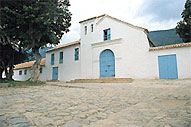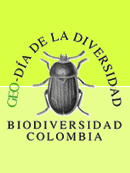|

Villa
de Leyva
Villa de Nuestra Señora de
Santa Maria de Leyva, known simply as ![]() ‘Villa de Leyva‘, is located in the west of Departamento de
Boyaca. The city was founded in the Zaquencipá valley in 1572 by the Spanish
Major Hernán Suárez de Villalobos on behalf of the Nuevo Reino de Granada,
Andrés Díaz Venero de Leyva.
‘Villa de Leyva‘, is located in the west of Departamento de
Boyaca. The city was founded in the Zaquencipá valley in 1572 by the Spanish
Major Hernán Suárez de Villalobos on behalf of the Nuevo Reino de Granada,
Andrés Díaz Venero de Leyva.
 At
that time, land was awarded to the Augustinian monk and chaplain von Federmán
Vicente de Requexada for the construction of the monastery of San Agustín
and the establishment of gardens. Following a long and
At
that time, land was awarded to the Augustinian monk and chaplain von Federmán
Vicente de Requexada for the construction of the monastery of San Agustín
and the establishment of gardens. Following a long and ![]() turbulent history the monastery was
finally abandoned in 1976. In 1992 it was rebuilt with the help of government
and municipal funding and its artistically valuable murals were restored.
In 1996 the historic building was taken over by the Alexander-von-Humboldt
Institute for Research into Biological Resources (Instituto Humboldt)
for use as its headquarters.
turbulent history the monastery was
finally abandoned in 1976. In 1992 it was rebuilt with the help of government
and municipal funding and its artistically valuable murals were restored.
In 1996 the historic building was taken over by the Alexander-von-Humboldt
Institute for Research into Biological Resources (Instituto Humboldt)
for use as its headquarters.
The ![]() Humboldt Institute is responsible for,
among other things,
Humboldt Institute is responsible for,
among other things, ![]() research into biodiversity in Colombia.
It promotes, coordinates and implements research work that contributes
to the protection and the sustainable utilisation of biodiversity in Colombia.
The institute
research into biodiversity in Colombia.
It promotes, coordinates and implements research work that contributes
to the protection and the sustainable utilisation of biodiversity in Colombia.
The institute ![]() was founded in 1993 and is one of the
scientific research facilities overseen by the Colombian Ministry of the
Environment. It is run as a public-benefit organisation whose
was founded in 1993 and is one of the
scientific research facilities overseen by the Colombian Ministry of the
Environment. It is run as a public-benefit organisation whose ![]() members come in particular from the
environment ministry, public and private universities, local governmental
and non-governmental organisations.
members come in particular from the
environment ministry, public and private universities, local governmental
and non-governmental organisations.
Since the early 1990s the Humboldt Institute has cooperated with various German partner organisations, including the Deutscher Akademischer Austauschdienst (DAAD; German Academic Exchange Service), the Deutsche Forschungsgemeinschaft (DFG; German Research Society), the Bundesamt für Naturschutz (BfN; Federal Office for Nature Conservation) and, since 1993, with GTZ.
The Humboldt Institute in collaboration with GTZ was holding a symposium entitled "200 years of biodiversity research: Colombia-Germany" in Villa de Leyva on June 7th and 8th 2001. This conference aimed to promote scientific exchange on ways of safeguarding biodiversity. As well as discussing current research topics, the symposium of course payed tribute to the man after whom the Institute is named - the naturalist and pioneering scientist of biodiversity Alexander von Humboldt, who is greatly admired in Latin America.
Directly after the symposium,
a unique project took place as part of ![]() GEO-Biodiversity Day: an inventory was
made of species in the Andes region around Villa de Leyva. Characteristic
of the Villa del Leyva region, which lies hardly 200 km north of Bogota,
is the particularly wide variety of its ecosystems and landscapes:
GEO-Biodiversity Day: an inventory was
made of species in the Andes region around Villa de Leyva. Characteristic
of the Villa del Leyva region, which lies hardly 200 km north of Bogota,
is the particularly wide variety of its ecosystems and landscapes:
-
The arid zone stretches out to the south-west where signs of degradation point to the impact of centuries of agricultural redevelopment.
-
In the centre and north-east we find a sub-humid zone in which most of the population are concentrated. The landscape here is characterised by virgin forests, which offer natural protection for the regions river systems.
-
The humid zone is covered by much of the Iguaque nature protection area, the Santuario de Flora y Fauna de Iguaque. The zone embraces a variety of ecosystems, including montane forests and dry forests reaching up to a height of more than 3,000 meters. The protected area contains various lagoons of ice-age origin and is the source of many tributaries of the Río Suárez.
![]() Detailed map of the Region (640x480; 100kb:
ca. 28 sec @ 28.800 baud; map designation in spanish)
Detailed map of the Region (640x480; 100kb:
ca. 28 sec @ 28.800 baud; map designation in spanish)

